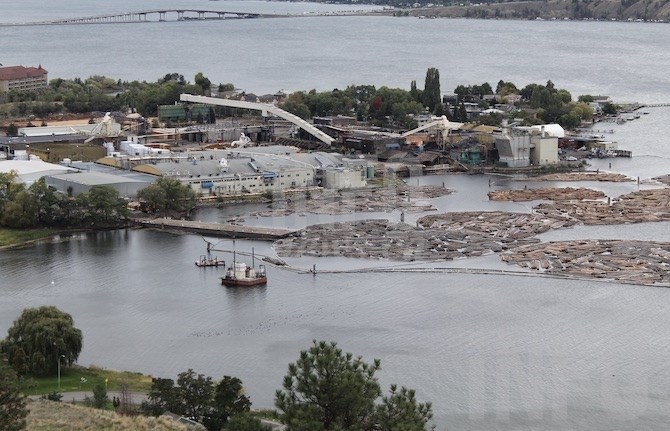
Tolko's Kelowna lumber million September 2019. Now the logs are gone and some of the buildings are coming down.
(ROB MUNRO / iNFOnews.ca)
November 07, 2020 - 9:00 PM
Certain pieces of a massive puzzle have to fit together just right if a major piece of Kelowna’s waterfront is ever going to be open to the public.
It’s up to Tolko to decide what it wants to do with the 40 acres of land near downtown Kelowna where part of its lumber mill is slowly being torn down.
Right now, Tolko is not talking about its plans. That leaves lots of room for speculation not only on what might ultimately be built there but also what contaminants might be in the soil after more than 90 years of sawmill operations.
The contamination part of the puzzle will be clearer by the end of February when a report by a contaminated site expert is due to go to the Ministry of Environment.
“They’re going to have to figure out what’s actually there and then provide a plan – if there is anything there – on how they’re going to clean it up,” Corey Davis, the City of Kelowna’s environmental coordinator told iNFOnews.ca. “We don’t know that information and neither does the province and, maybe, not even Tolko yet.”
The province is not commenting because its communications departments are still restricted in what they can say to the media until after the final results are in from the provincial election.
The environmental review process became mandatory with a one-year deadline for completion in February when Tolko went to the city to apply for a demolition permit for six of the structures on site – something Davis refers to as minor demolition.
Under provincial regulations, municipalities have to inform the Ministry of Environment when certain applications are made to cities – such as rezonings and demolitions – for industrial lands.
That process was triggered on Feb. 20 when Tolko applied for a demolition permit that was issued Sept. 3. It refers to six structures that are to be removed but not the larger buildings.
At this point, that’s all the work that can be done on the site.
The city is in a “freeze and release” situation with the property now that the environmental review has been ordered, Davis said.
That means any further applications for permits of any sort will be frozen until the province gives its approval.
Regardless of what work needs to be done to clean up any contaminants on the site and how it’s redeveloped, there is no guarantee that the public will ever have access to the waterfront.
It’s currently zoned industrial and, depending on where it builds, Tolko could go ahead with a project without even needing a development permit that controls its form and character, Ryan Smith, the city’s community development department manager said.
No buildings can be constructed within 15 metres of Okanagan Lake’s high water mark but, even if development permits are needed, those don’t control public access to the waterfront.
The only way that will happen is if the land is rezoned.
If the land is to be rezoned, it creates the opportunity to have a broader discussion about how redevelopment of the site will impact the surrounding area.
“We want to connect, sort of, the base of Knox Mountain and this property... to Brandt’s Creek and that linear park to the south there – the Recreation Avenue area,” Smith said. “How does all that come together and work well with downtown? Those questions all have to be answered. What’s the right amount of parkland in that area? Are there any impediments to development? What’s the status of the land under the mill? Is there any contamination that has to be cleaned up? All those things will help inform development. That 40 acres would likely be the focus but we would be looking at connections beyond that 40 acres.”
That’s an extensive planning process that, in itself, could easily take a year-and-a-half to complete. But it would give the city the leverage to negotiate with the developer with the aim that land along the waterfront be donated to the city.
Only then will public access to the lake between Manhattan Point and Sutherland Park be possible and, the land would come at no cost to the taxpayer.
To contact a reporter for this story, email Rob Munro or call 250-808-0143 or email the editor. You can also submit photos, videos or news tips to the newsroom and be entered to win a monthly prize draw.
We welcome your comments and opinions on our stories but play nice. We won't censor or delete comments unless they contain off-topic statements or links, unnecessary vulgarity, false facts, spam or obviously fake profiles. If you have any concerns about what you see in comments, email the editor in the link above.
News from © iNFOnews, 2020